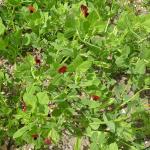Growing Asparagus Pea, also Winged bean
Lotus tetragonobolus : Fabaceae / the pea or legume family
| Jan | Feb | Mar | Apr | May | Jun | Jul | Aug | Sep | Oct | Nov | Dec |
|---|---|---|---|---|---|---|---|---|---|---|---|
| P |
(Best months for growing Asparagus Pea in USA - Zone 5a regions)
- P = Sow seed
- Easy to grow. Sow in garden. Sow seed at a depth approximately three times the diameter of the seed. Best planted at soil temperatures between 15°C and 20°C.
- Space plants: 20 - 25 cm apart
- Harvest in 8-11 weeks. Pick early, pick often.
- Compatible with (can grow beside): Best grown in separate bed
This low spreading plant has small trifoliate leaves, and deep crimson flowers are borne in pairs. Harvest pods when approximately 2.5 cm (1 in) long. ( about 80 days)
Asparagus pea is easy to cultivate. It needs average moisture, full sun, and ordinary soil.
It needs a long growing season to flower and fruit properly, so start it indoors in cooler areas.
Only the pods are edible for Lotus tetragonobolus.
Not to be confused with the other asparagus pea, the tropical plant Psophocarpus tetragonolobus, also known as Goa bean.
Support with twigs to keep the stems off the ground. Protect from slugs and snails. Pick pods when small as they become hard and dry if left too long.
Culinary hints - cooking and eating Asparagus Pea
Cook quickly by steaming and serve with just a touch of butter and they are said to taste like their namesake .



Your comments and tips